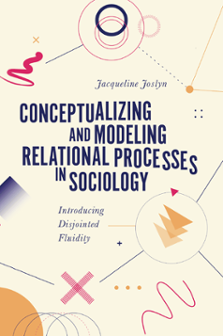
Prelims
Conceptualizing and Modeling Relational Processes in Sociology
ISBN: 978-1-80382-828-2, eISBN: 978-1-80382-827-5
Publication date: 28 September 2022
Citation
Joslyn, J. (2022), "Prelims", Conceptualizing and Modeling Relational Processes in Sociology, Emerald Publishing Limited, Leeds, pp. i-xiii. https://doi.org/10.1108/978-1-80382-827-520221010
Publisher
:Emerald Publishing Limited
Copyright © 2022 Jacqueline Joslyn. Published under exclusive licence by Emerald Publishing Limited
Half Title Page
Conceptualizing and Modeling Relational Processes in Sociology
Title Page
Conceptualizing and Modeling Relational Processes in Sociology: Introducing Disjointed Fluidity
By
Jacqueline Joslyn
University of Arizona, USA

United Kingdom – North America – Japan – India – Malaysia – China
Copyright Page
Emerald Publishing Limited
Howard House, Wagon Lane, Bingley BD16 1WA, UK
First edition 2022
Copyright © 2022 Jacqueline Joslyn.
Published under exclusive licence by Emerald Publishing Limited.
Reprints and permissions service
Contact: permissions@emeraldinsight.com
No part of this book may be reproduced, stored in a retrieval system, transmitted in any form or by any means electronic, mechanical, photocopying, recording or otherwise without either the prior written permission of the publisher or a licence permitting restricted copying issued in the UK by The Copyright Licensing Agency and in the USA by The Copyright Clearance Center. Any opinions expressed in the chapters are those of the authors. Whilst Emerald makes every effort to ensure the quality and accuracy of its content, Emerald makes no representation implied or otherwise, as to the chapters' suitability and application and disclaims any warranties, express or implied, to their use.
British Library Cataloguing in Publication Data
A catalogue record for this book is available from the British Library
ISBN: 978-1-80382-828-2 (Print)
ISBN: 978-1-80382-827-5 (Online)
ISBN: 978-1-80382-829-9 (Epub)


Dedication
To Carmela Joslyn (my mom), Clara Pasto and Jennie Joslyn (my grandmothers), Jennifer Joslyn-Mahuta (my sister), and to all strong women: Thank you for giving me so many pixels to share.
List of Figures
| Chapter 1 | |
| Figure 1. | Zooming in on a Social Tie. |
| Figure 2. | Relationship Trajectories Evolving Over Time. |
| Figure 3. | RIECOs Are the Building Blocks of Relationship Constructs. |
| Figure 4. | Does a Relationship Exist? |
| Chapter 4 | |
| Figure 5. | Zooming in on a Social Tie to Show Pixels. |
| Figure 6. | Comparison of Pixel Trail Changes After Gender Awareness Training. |
| Figure 7. | Natalie-Denise Dyadic Structure as Pixels and Flows. |
| Figure 8. | Natalie Passing a Secondhand Pixel to a Student. |
| Figure 9. | Pixel Trajectory Foundations for Conformity, Loyalty, and Innovation. |
| Figure 10. | Fading and Merging of Pixels Over Time. |
| Chapter 5 | |
| Figure 11. | Average Marginal Effects of Gender for Nonsexual Discrimination (Hypothesis 2b). |
| Figure 12. | Average Marginal Effects of Gender for Sexual Discrimination (Hypothesis 2b). |
| Figure 13. | Average Marginal Effects of Gender for Nonsexual Discrimination (Hypothesis 2b, Control Variable Incl.). |
| Figure 14. | Average Marginal Effects of Gender for Sexual Discrimination (Hypothesis 2b, Control Variable Incl.). |
List of Tables
| Chapter 2 | |
| Table 1. | Internal Mechanisms of Continuity. |
| Chapter 3 | |
| Table 2. | External Mechanisms of Continuity. |
| Chapter 5 | |
| Table 3. | Logistic Regression Models of Sexual and Nonsexual Discrimination for Additive Effects (Odds Ratios). |
| Table 4. | Logistic Regression Models of Sexual and Nonsexual Discrimination With Average Marginal Effects (Probabilities). |
| Appendix A | |
| Table 5. | Demographics for Part II. |
| Table 6. | Demographics for Part I. |
| Table 7. | Mentorship Statistics by Gender. |
Acknowledgments
I would like to express my deepest appreciation to my dissertation cochairs, Joseph Galaskiewicz and Robin Stryker. Their astute advice, feedback, and encouragement has been so very instrumental to every aspect of this research. I am wholeheartedly grateful to my dissertation committee members, Ronald Breiger and Brian Hilligoss, for their generous guidance and suggestions. Thank you to the University of Arizona Graduate and Professional Student Council for providing funding for this research. I would like to recognize Nina Eliasoph and the Junior Theorists Symposium volunteers for providing critical feedback and allowing me to bring disjointed fluidity to the attention of the scholarly community. A special thank you to Corey Abramson for his valuable literature recommendations. I would also like to acknowledge Albert Bergesen. Our conversations were a valuable and cherished source of creative inspiration. I lovingly thank my friends and family for all the support, which I will forever pay forward.